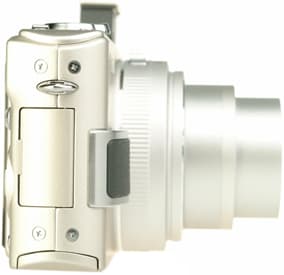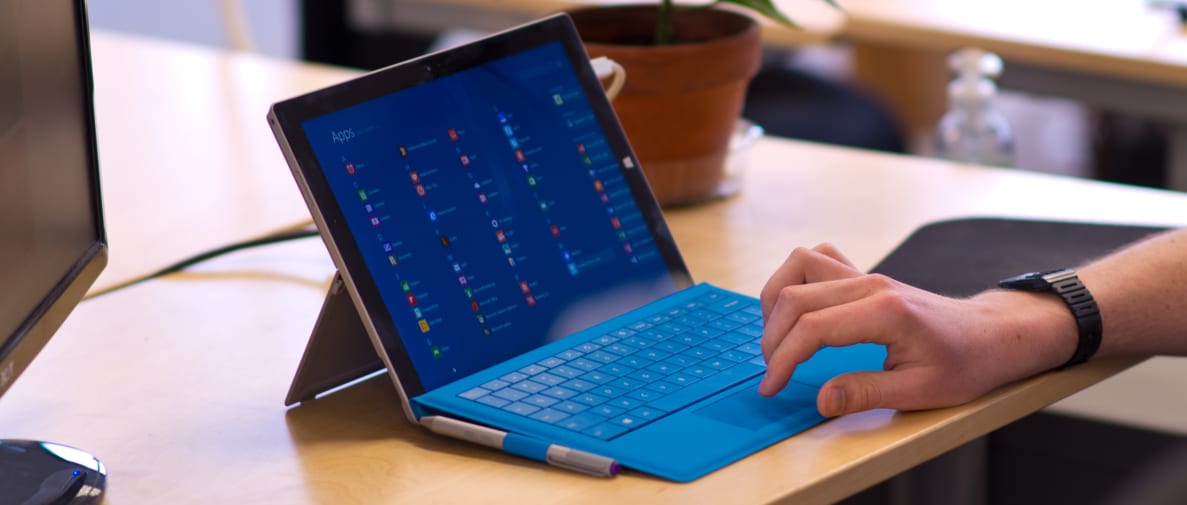It's frustrating because despite loads of convertible devices that try to bridge the gap, nothing has really hit the spot. Why can't there be a device that is lightweight and simple to use like a tablet, but also powerful enough to easily run full games and programs like Microsoft Office? Why can't we just have one device that does everything?
Microsoft tried to solve just this problem with its original Surface vision. Unfortunately, the first Surface tablet—the Surface RT—fell flat on its face with sub-par performance and a lack of RT-compatible software. The first Surface Pro offered a bit more under the hood, but didn't really compete well with laptops: It had full Windows, but somewhat lackluster specs for the price. And though both Surfaces offered acceptable battery life, the screens were... less than stellar.
With the new Surface Pro 3 (MSRP $799.99 and up), all of that is out the window. Though it may look the same on the outside, closer inspection reveals a startlingly sophisticated device. This time, Microsoft crammed a competitive ultrabook into a tablet's body—at a price. Forget trying to compete with iOS and Android tablets—devices like the Surface Pro 3 may render them irrelevant altogether.
Design
Microsoft gives its baby a complete overhaul
For the Surface Pro 3, Microsoft kept Windows 8.1 and the VaporMg casing, and then completely redesigned the tablet from stem to stern. It may look similar, but almost everything is different now: The guts of the device are geared to compete, the screen is vastly improved over its predecessor, and just about every little rough edge has been polished away to leave a device that is truly special. It's rare to see even a third generation device that is so well informed by the failings of its predecessors.
{{ photo_gallery "tour" }}
While we'll leave our thoughts on the Pro 3's so-called "lapability" for our upcoming laptop version of this review, there's a lot to like about the slate's abilities as a tablet. There may be some sore spots when it comes to using software with the touchscreen, but this is honestly the first tablet that we're comfortable calling a true laptop replacement. Though many have searched far and wide for this goldilocks sweet-spot of form and function, this is the device that gets it just about right.
If we're forced to pick nits with the Surface Pro 3, the tablet side of things is where we'd do it. While it is incredibly thin and light for a laptop, it's slightly heavier and thicker than most of the tablets it'll be competing with. If you're used to doing everything with an iPad Air, for example, the Pro 3 is going to feel heavy. That's largely because of the processor it packs, but also because of the (relatively) enormous 12-inch screen.
Microsoft has at least tried to make the Surface more comfortable to use as a tablet. Most notably, the capacitive Windows icon has been moved to the right of the screen for easier access via thumb. And though the new and improved kickstand pays far more dividends when you need the Pro 3 to be a laptop, its increased range is also boon any time you want to kick back and watch a video without having to hold it by hand.

Another area where the Surface Pro 3 really sets itself apart from other tablets is the ability to use a wide range of peripherals. Again, we'll address things like the incoming docking station in our laptop review, but the inclusion of a full USB 3.0 port and a 4K-ready Mini DisplayPort for driving an external display puts the Surface Pro 3 on another level compared to most tablets. Simply the fact that you can hook up an external HDD without wonky workarounds makes the Pro 3 one of the best media consumption tablets on the market. And that's before we even discuss the excellent Surface Pen, which is included by default and makes jotting down quick reminders and notes incredibly easy.
Last but not least, the Surface Pro can also make use of the excellent Type cover. Though the new Type cover will set you back an additional $129.99, it's a superb investment for those times when you need to sit down and write something longer than a quick e-mail. It has a much larger touchpad that feels as good as just about any current Windows 8 laptop and we were easily able to hit 40+ WPM with its keys right out of the box. If you are picking up the Surface Pro 3 as a do-it-all device, it should be considered standard equipment.
In Use
Why choose between a laptop and a tablet when you can have both?
All of the hardware changes discussed above only scratch the Surface of why this tablet is a joy to use. Microsoft's hardware team is quickly developing a reputation for extreme levels of polish, and the Pro 3 is a perfect example of why. However, minor changes and polish don't mean a thing unless the device is actually a pleasure to use. In that regard the Surface Pro 3 takes other tablets to task, despite the occasional hitch of stuffing the full Windows experience into a touch-centric device.
{{ photo_gallery "design" }}
When it comes to usability, a tablet's limiting factor isn't necessarily its form: it's the touch interface you use to operate it. Because the primary means of interaction with your tablet is by touch, you have to be able to hold it with one hand and operate it with the other. Most tablets seem to forget this, instead designing slates around 16:9 video content. But a tablet isn't a TV. It's not a dumb machine you set up on a table and forget about. It's more like a book, something that you hold and enjoy interacting with.
Microsoft seems to have realized this error as the Surface's aspect ratio has changed from 16:9 to 3:2. While 16:9 maximizes screen real estate for video content, it's too awkward to use vertically. While 3:2 screens give you black bars on the top and bottom while watching video, they better facilitate reading books or web pages. That fact alone doesn't sound all that amazing, but consider this: If you're using a touchscreen, you need your hands to be able to touch as much of the visible area as possible, and you can't do that with one side significantly longer than the other (unless the device is tiny). Apple saw the same wisdom and has been using a 4:3 aspect ratio (the same as letter paper) for its iPads all along.

There's the obvious tradeoff of wasted screen area when it comes to watching video, but 3:2 is a great compromise aspect ratio. It wastes less screen area while playing videos than the iPad, and it's much more friendly to PDFs, presentations, and note-taking. It also throws a bone to content creators, making more screen real estate available for programs like the Adobe Creative Cloud suite. You still can't easily reach every inch of the screen while holding it horizontally, but there's a lot more within reach than the older Surface Pro 2.
It's not all roses, however. This is still a Windows 8.1 device, and with that comes some major benefits and some minor headaches. We'll start with the good news: It'll run any Windows 8.1 program you need it to, including full versions of Office, Photoshop, Steam games—just about anything. The bad news: Windows is such a massive, fractured platform that it may not have the equipment (e.g. a disc drive) that those programs require. As such, getting some programs to work correctly can require some creative hoop-jumping. Also, you may or may not be a fan of the Metro-style start screen and live tiles. You can always load up the classic desktop look, but it's not exactly scaled for easy use with a touchscreen.
The new included Surface Tablet Pen that we discussed earlier alleviates some of these concerns. Though it's not as sensitive as the Wacom-based pen that came with previous versions, its 256 levels of pressure sensitivity are just fine for writing and sketching. At least one professional cartoonist and Surface enthusiast we know of found the pen to be just fine, though the Core i5 processor in the early review units does appear to result in some sluggishness when dragging icons. The new pen also has a neat trick where you can simply hit the purple button on back to launch Microsoft OneNote. It's the kind of approachable touch that makes the Surface feel like a natural extension of what you're already accustomed to.
{{ photo_gallery "software" }}
Performance
The end could be nigh for high-end tablets.
If you've ever gone shopping for a tablet, you may have noticed that there isn't all that much different from one to the next. There can be big differences if you just look at a spec sheet, but in the tablet space that rarely translate to improved performance. Now that the category has caught up with the low end of laptops, we're starting to see a sort of leveling-off of competition, where most tablets easily clear the "good enough" hurdle. There's only so much performance you need to play Angry Birds. While that may be true of conventional tablets, the Surface Pro 3 changes the equation.
Though the Surface Pro 3 on its own is a tablet, it actually has more in common with the MacBook Air. Consider that the Pro 3 combines the same Intel processors that make the Airs tick as well as a gorgeous screen, 7+ hour battery life, and in a package that's lighter and thinner than the Air. That's the kind of product that will shake up the tablet market.

Of course, the Pro 3 is hardly the first convertible tablet with such ambitions. But compared to the iPads and Galaxy Tabs of the world, the earlier iterations of the Surface project were handily beaten for both battery life and screen performance. With the Pro 3 that advantage is no more; it has ceased to be. The Pro 3's 10x6.625-inch screen (12" diagonal) crams in a wonderful 2160x1440 pixels. That doesn't quite clear the "Retina" standard that Apple made up, but it replicates print quality. If you have 20/20 vision, you simply won't notice the difference unless your eyes are pressed on the screen.
Add to that great color performance and decent contrast, and the only really glaring problem (see what I did there?) is reflectivity. Indoors and in shaded areas you won't see an issue, but the Pro 3 isn't usable on a bright day at the beach. Sorry, workaholics, no pivot tables at the beach for you. If you don't seek shade, you're also going to need to max out the backlight—draining battery life. Normally this isn't much of a problem for a tablet, but that Intel processor and giant screen suck down a lot of juice. Though it's about par for the course for a regular laptop, six and a half hours watching video is on the low end of average for a tablet.

A device with 8 gigabytes of RAM, an Intel Core processor (the Pro 3 comes in i3, i5, i7 models), 256 gigabytes of solid-state drive space, along with even a pedestrian laptop graphics chip is completely overpowered in comparison to most tablets. Though we don't account for benchmark scores between tablets, the Surface Pro 3 absolutely wrecks everything else by an enormous margin. In fact, we tested the Surface Pro 3 as a laptop as well, and the i5 model scored within the top 10% of all laptops (as of May 22, 2014). And that's the middle-of-the-road review unit option: What hope does a tablet have in comparison? For most mobile apps, it's like using a chainsaw to cut butter.
Conclusion
Alea iacta est
It seems a bit early to crown the Surface Pro 3, but even playing solely by tablets' rules, it's a remarkably better device than most other tablets. Ignore the kickstand. Ignore the Intel-powered processor. Ignore the fact that this will run just about any game or piece of desktop software from the last decade. Ignore the ability to use this to easily power a competent desktop workstation. It's still one of the best tablets money can buy. It's (relatively) expensive, sure, but it's rare for a device to straddle two categories so confidently and with so few sacrifices. Not only can it bring the world of Windows users into the tablet world, but it can also satisfy those that need a device more substantial than an iPad. From the screen to the system, this is a world-beater tablet by any objective measurement we can come up with.
To Microsoft's credit, after failing to unseat the iPad with the original Surface RT, the company's hardware engineers pivoted and have really pulled out all the stops here. The Surface Pro 3 looks beyond the iPad, instead taking aim straight at the Macbook Air. We'll reserve our conclusions on that particular fight for the upcoming Surface Pro 3 laptop review, but suffice it to say that a tablet as powerful as an Air that runs full Windows 8.1 has our attention.

We've seen something like this coming for a long time now, as many don't want to buy a computer and a tablet. The Surface Pro 3 isn't revolutionary, but it's the first device that is comfortable to handle for casual browsing and powerful enough to handle serious professional use. Microsoft has crossed the Rubicon.
Of course, that premium package sitting at the top of the tablet heap also comes at a king's ransom. Though the entry-level option comes in at a hair under $800 USD, that doesn't include the updated type cover ($129.99). And grabbing a better-specced Surface Pro can run you anywhere from $1,000 to nearly $2,000. That's a lot of money to pay for a tablet, though it's right in line with what Apple charges for its Macbook Airs of similar quality. That price also becomes a lot more palatable considering this serves both as a top-end laptop and a best-in-class tablet.
As lovely as we find the Surface Pro 3, if we're being honest, it's an incredibly overpowered machine if all you're going to do is watch Netflix or browse the web. For that, we recommend simply picking up a Nexus 7, iPad Air, Surface 2, or any Chromebook. For anyone who needs a more advanced machine the Surface Pro 3 may not be a bargain, but it is absolutely worth every penny.
Science Introduction
It's all fine and well to say that a product is a great tablet, but now it's time for me to show my work.
I wasn't surprised at all that the Surface Pro 3 scored so well, but tablets don't get scored on benchmarks. That high score is based on usability, screen performance, and battery alone. Until we publish the laptop review of the Surface Pro 3, the insane guts of the Surface Pro don't even factor into the equation just yet.
Screen Performance
Window to the world
Marking a radical departure from previous designs, the Surface Pro 3 has a 10 x 6.625-inch screen with 2160 x 1440 pixels. That means a 216 PPI display that's retina beyond 16 inches away. It's a big step up for a device that doubles as a laptop, as there are very few sub-kilogram devices that pack in that many pixels.

On top of all that, the color gamut and black and white performance is also quite respectable. Photographers and graphic designers will appreciate the near-ideal color gamut, and the notably low black level of 0.25 cd/m2 . It's not quite at HDTV standards yet, but it's closing in on that level of performance. Better than the iPad, at any rate.
I will say that the screen's brightness is quite low for a tablet. Though in the context of a well-lit room 296.52 cd/m2 is enough to cause some eye discomfort, in direct sunlight you'll have issues seeing images. LCDs are famed for their inability to dispel direct sunlight because they rely on a backlight to overpower ambient light in order to show their image. The Surface Pro—along with most other tablets and laptops—struggle here.
This does make the screen appear more reflective than it really is. Though the Surface Pro 3 only sends back 3.6% of direct light and 7.5% of all light, bright sources of light will look far more distracting because they typically are so much brighter than the screen itself.
Battery Life
Could be better, could be worse.
It's a bit hard to remember that this tablet has some insanely-overpowered guts running the show under the hood. Consequently, battery life is a bit lackluster. You can sometimes get away with turning down the screen brightness to squeeze a little more life out, but because it's so dim anyways you're probably going to leave it at full brightness.
With all wireless connections disabled and the brightness at full, the Surface Pro 3 lasted 6 hours, 28 minutes playing back HD video. Low-average to be sure, but long enough to be taken on a short flight to avoid the terrible movies.
Maybe it's due to that weak backlight, but the Surface Pro 3 can cram in about 7 hours and 16 minutes of reading eBooks. That's fairly decent, all things considered. Not wonderful for bookworms, but at least it's nice to know that you're covered for most quick reading sessions after work.
Other Tests
Yowza.
Though we currently don't reflect processor performance in tablets, I need to make special mention of just how blisteringly fast an Intel Core i5 processor is in comparison to even the most juiced-up ARM processors. Tablets as a whole can't compete with most laptops in terms of processing power... except for the Surface Pro 3.
Our laptop testing uses extensive processor tests, and even the Core i5 model of the Surface Pro 3 trounced last year's MacBook Air in scoring. We asked Microsoft for a Core i7 model, and we were a bit incredulous when they told us they were comfortable with us testing the lesser model against the rest of the laptop lineup. It seemed like hubris at first, but it was merely informed confidence.
I will say that the GPU the Surface Pro 3 packs is a lot less powerful than a dedicated graphics card, so don't expect to play games without a hitch. We were only able to get Metro: 2033 working at somewhere between 6 and 21 frames per second, which is fairly terrible if you care about gaming. Many indie games are merely platformers, and the Surface Pro 3 seems to do okay with those, but MMO games are very tough to stomach with an anemic GPU.
Meet the tester
A seasoned writer and professional photographer, Chris reviews cameras, headphones, smartphones, laptops, and lenses. Educated in Political Science and Linguistics, Chris can often be found building a robot army, snowboarding, or getting ink.
Checking our work.
Our team is here for one purpose: to help you buy the best stuff and love what you own. Our writers, editors, and lab technicians obsess over the products we cover to make sure you're confident and satisfied. Have a different opinion about something we recommend? Email us and we'll compare notes.
Shoot us an email




